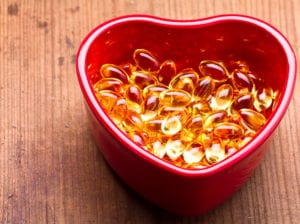Written by Taylor Woosley, Staff Writer. Analyzing data from 4570 patients with osteoarthritis shows that subjects with sufficient serum 25(OH)D were associated with a decreased risk of all-cause mortality and CVD mortality compared with those with lower 25(OH)D levels.
 Osteoarthritis (OA) is the most prevalent chronic joint disease and is a leading cause of disability in older adults1. OA affects 240 million people globally, about 10% of men and 18% of women2. It is a painful joint disease characterized by progressive degeneration of the articular cartilage as well as associated changes to the subchondral bone, synovium, and surrounding joint tissues3. One of the most important factors in the pathogenesis of OA is a disturbed cytokine balance in favor of proinflammatory cytokines that initiate a vicious cycle that leads to damage to cartilage4.
Osteoarthritis (OA) is the most prevalent chronic joint disease and is a leading cause of disability in older adults1. OA affects 240 million people globally, about 10% of men and 18% of women2. It is a painful joint disease characterized by progressive degeneration of the articular cartilage as well as associated changes to the subchondral bone, synovium, and surrounding joint tissues3. One of the most important factors in the pathogenesis of OA is a disturbed cytokine balance in favor of proinflammatory cytokines that initiate a vicious cycle that leads to damage to cartilage4.
Several factors, such as obesity, age, ethnicity, and vitamin D deficiency, have been shown to play a role in the development as well as progression of OA5. Vitamin D, a steroid hormone, is known to increase bone mass and prevent bone loss through the regulation of calcium homeostasis6. Previous research has shown that the casual effect of vitamin D on OA progression tends to point to a protective effect in patients with low vitamin D status7.
Wang Jing et al. conducted a study to assess whether vitamin D (serum 25(OH)D) concentrations were associated with all-cause and cause-specific mortality in subjects with OA using data from NHANES III (1988 to 1994) and NHANES 2001-2018 database. Subjects aged >18 years were included in the analysis if they had self-reported OA, with available 25(OH)D concentration measurements. 25(OH)D levels were measured in NHANES III using the DiaSorin RIA kit and for NHANES 2001-2018 levels were measured using a standardized liquid chromatography-tandem mass spectrometry (LC-MS/MS) method. A number of variables, including demographic age, gender, race, education level, health status including BMI, and lifestyle factors such as physical activity, were identified as potential cofounders in the analysis. Additionally, whole-blood biochemical markers, including lead and C-reactive protein (CRP), were also considered in the sensitivity analysis.
OA subjects were classified into four categories: severe (serum 25(OH)D < 25.0 nmol/L), moderate deficiency (25.0-49.9 nmol/L), insufficient (50.0-74.9 nmol/L), and sufficient (≥75.0 nmol/L). X2 tests were utilized for categorical variables and generalized linear regressions were used for continuous variables. Stratified analyses for all-cause mortality were performed to observe underlying effect modification, including age, gender, BMI, smoking status, physical activity, and renal disease.
The final analysis included 4570 OA patients, with 65.53% being female, and a mean age of 61.82 ± 12.94 years. The geometric mean (95%CI) of serum 25(OH)D concentration was 63.90 (95%CI: 63.08-64.73) nmol/L. 16.54% of subjects were vitamin D deficient and 48.5% were vitamin D insufficient. After multivariable adjustment, categories with higher 25(OH)D levels were significantly related to a lower risk of all-cause mortality and CVD mortality. The multivariable-adjusted HRs (95% CIs) across four categories of serum 25(OH)D concentrations were 1.00 (reference), 0.49 (0.31, 0.75), 0.45 (0.29, 0.68), and 0.43 (0.27, 0.69) for all-cause mortality and 1.00 (reference), 0.28 (0.14, 0.59), 0.25 (0.12, 0.51), and 0.24 (0.11, 0.49) for CVD-specific mortality.
Findings of the study show that vitamin D provides a protective role in reducing mortality among OA patients. Furthermore, after a median follow-up of 7.6 (interquartile range: 4.2-12.3) years, an L-shaped association was found for all-cause mortality. A serum 25(OH)D concentration of 84.50 nmol/L was associated with the lowest all-cause mortality risk. Study limitations include the lack of repeated vitamin D measurements, the self-reporting nature of OA diagnosis among subjects, and the limited statistical power for detecting associations between 25(OH)D and cancer-specific mortality.
Source: Wang, Jing, Jiayao Fan, Ye Yang, Sara Moazzen, Dingwan Chen, Lingling Sun, Fan He, and Yingjun Li. “Vitamin D Status and Risk of All-Cause and Cause-Specific Mortality in Osteoarthritis Patients: Results from NHANES III and NHANES 2001–2018.” Nutrients 14, no. 21 (2022): 4629.
© 2022 by the authors. Licensee MDPI, Basel, Switzerland. This article is an open access article distributed under the terms and conditions of the Creative Commons Attribution (CC BY) license (https:// creativecommons.org/licenses/by/ 4.0/).
Click here to read the full text study.
Posted January 10, 2023.
Taylor Woosley studied biology at Purdue University before becoming a 2016 graduate of Columbia College Chicago with a major in Writing. She currently resides in Glen Ellyn, IL.
References:
- O’Neill TW, Felson DT. Mechanisms of Osteoarthritis (OA) Pain. Curr Osteoporos Rep. Oct 2018;16(5):611-616. doi:10.1007/s11914-018-0477-1
- Morales-Ivorra I, Romera-Baures M, Roman-Viñas B, Serra-Majem L. Osteoarthritis and the Mediterranean Diet: A Systematic Review. Nutrients. Aug 7 2018;10(8)doi:10.3390/nu10081030
- Guilak F, Nims RJ, Dicks A, Wu CL, Meulenbelt I. Osteoarthritis as a disease of the cartilage pericellular matrix. Matrix Biol. Oct 2018;71-72:40-50. doi:10.1016/j.matbio.2018.05.008
- Molnar V, Matišić V, Kodvanj I, et al. Cytokines and Chemokines Involved in Osteoarthritis Pathogenesis. Int J Mol Sci. Aug 26 2021;22(17)doi:10.3390/ijms22179208
- Heidari B, Babaei M. Therapeutic and Preventive Potential of Vitamin D Supplementation in Knee Osteoarthritis. ACR Open Rheumatol. Jul 2019;1(5):318-326. doi:10.1002/acr2.1042
- Zafeiris EP, Babis GC, Zafeiris CP, Chronopoulos E. Association of vitamin D, BMD and knee osteoarthritis in postmenopausal women. J Musculoskelet Neuronal Interact. Dec 1 2021;21(4):509-516.
- Park CY. Vitamin D in the Prevention and Treatment of Osteoarthritis: From Clinical Interventions to Cellular Evidence. Nutrients. Jan 22 2019;11(2)doi:10.3390/nu11020243
